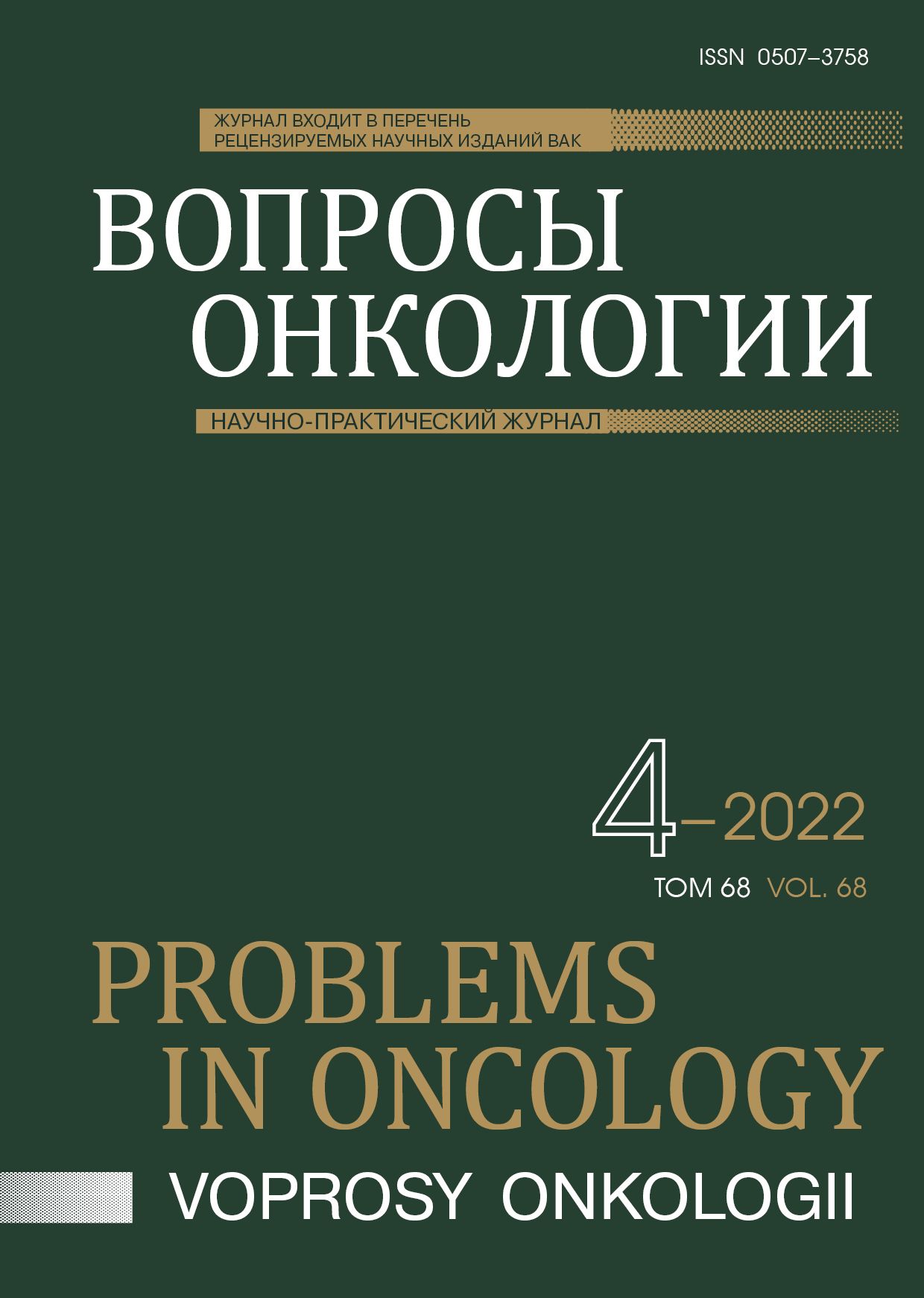Abstract
Purpose: to present the first results of a randomized study of two various radiotherapy fractionation schemes in glioblastoma (GBM)
Material and methods: Patients with GBM in subgroups older and younger than 50 years were alternately used a radiation therapy regimen with a prescribed dose of 2 and 3 Gy (research involving paired selection strategy). After recruiting 120 patients, a predictor of continued growth was included in the study design after microsurgical intervention. In total, the study included 70 patients treated with the prescribed dose of 2 and 3 Gy. Continued growth after microsurgical intervention was diagnosed in 60 patients, there was no growth in 80 patients.
Results: In general, as of December 2021, a recurrence was recorded in 105 patients out of 140 (75%): 62 patients were diagnosed with central recurrence (44.3%), 28 with marginal localization (20%) and in 15 had a distant form of growth as the first manifestation of glioma progression (10.7%). The predictors of local progression were continued growth after microsurgical intervention (OR=1,916; p=0,003), the use of temozolomide in conjunction with radiation therapy (OR=0,502; p=0,002) and homogeneity index level over 8.5 (OR=0,535; p=0,009) was significant. The radiotherapy fractionation schemes plays a definite role, the 3 Gy regimen improves the results according to the criterion of local recurrence (OR=0,620; p=0,022).
Conclusion: patients with and without continued growth after microsurgical intervention belong to different prognostic groups, the results of treatment in them should be considered separately. The first data from the randomized study show that the radial therapy regimen with the prescribed dose of 3 Gy is as good as the standard program in terms of primary and local progression.
References
Stupp R, Tonn JC, Brada M, Pentheroudakis G. High-grade malignant glioma: ESMO Clinical Practice Guidelines for diagnosis, treatment and follow-up // Annals of oncology. 2010;21 Suppl 5:v190-3. doi:10.1093/annonc/mdq187
Lee SW, Fraass BA, Marsh LH et al. Patterns of failure following high-dose 3-D conformal radiotherapy for high!grade astrocytomas: a quantitative dosimetric study // Int. J. Radiat. Oncol. Biol. Phys. 1999;43(1):79-88.
Chan JL, Lee SW, Fraass BA et al. Survival and failure patterns of high grade glioma after three-dimensional conformal radiotherapy // J Clin Oncol. 2002;20(6):1635-42. doi:http://dx.doi.org/10.1200/jco.20.6.1635
Stupp R, Hegi ME, Mason WP et al. Effects of radiotherapy with concomitant and adjuvant temozolomide versus radiotherapy alone on survival in glioblastoma in a randomised phase III study: 5-year analysis of the EORTC-NCIC trial // Lancet Oncol. 2009;10(5):459-66. doi:10.1016/S1470-2045(09)70025-7
Shenouda G, Souhami L, Petrecca K et al. A Phase 2 Trial of Neoadjuvant Temozolomide Followed by Hypofractionated Accelerated Radiation Therapy With Concurrent and Adjuvant Temozolomide for Patients With Glioblastoma // Int J Radiat Oncol Biol Phys. 2017;97(3):487-494. doi:10.1016/j.ijrobp.2016.11.006
Azoulay M, Santos F, Souhami L et al. Comparison of radiation regimens in the treatment of Glioblastoma multiforme: results from a single institution // Radiat Oncol. 2015;10:106. doi:10.1186/s13014-015-0396-6
Hingorani M, Colley WP, Dixit S et al. Hypofractionated radiotherapy for glioblastoma: strategy for poor-risk patients or hope for the future? // Br J Radiol. 2012;85(1017):e770–e781. doi:10.1259/bjr/83827377
Герасимов В.А., Болдырева В.В., Даценко П.В. Гипофракционирование при глиобластомах: изменение парадигмы лучевого лечения // Вопросы нейрохирургии. 2017;81(6): 116-124. doi:10.17116/neiro2017816116-124 [Gerasimov VA, Boldyreva VV, Datsenko PV. Hypofractionated radiotherapy for Glioblastoma: changing the radiation treatment paradigm // Voprosy neirokhirurgii. 2017;81(6):116-124 (In Russ.)]. doi:10.17116/neiro2017816116-124
Ciammella P, Galeandro M, D'Abbiero N et al. Hypo-fractionated IMRT for patients with newly diagnosed glioblastoma multiforme: a 6 year single institutional experience // Clin Neurol Neurosurg. 2013;115(9):1609-14. doi:10.1016/j.clineuro.2013.02.001
Дружинин В.Н. Экспериментальная психология: Учебное пособие. М.: ИНФРА-М, 1997. [Druzhinin VN. Jeksperimental'naja psihologija: Uchebnoe posobie. M.: INFRA-M, 1997.(In Russ.)].
Герасимов В.А., Плавник Р.Н., Даценко П.В. Алгоритм послеоперационной лучевой терапии с предписанной дозой 3 Гр при глиомах высокой степени злокачественности // Онкология. 2018;3(7):24-31 doi:10.17116/onkolog20187324 [Gerasimov VA, Plavnik RN, Datsenko PV. Algorithm for postoperative radiotherapy with a prescribed dose of 3 Gy for high-grade Gliomas // Oncologiya. 2018;7(3):24-31 (In Russ.)]. doi:10.17116/onkolog20187324
Даценко П.В., Болдырева В.В., Герасимов В.А. Факторы риска рецидива в границах CTV-PTV при глиомах высокой степени злокачественности после альтернативных режимов лучевой терапии // Онкология. 2017;6(4):20-28. doi:10.17116/onkolog20176420-28 [Datsenko PV, Boldyreva VV, Gerasimov VA. Recurrence risk factors within the CTV-PTV margins in high-grade Gliomas after alternative radiotherapy regimens // Oncologiya. 2017;6(4):20-28 (In Russ.)]. doi:10.17116/onkolog20176420-28
Rapp M, Baernreuther J, Turowski D et al. Recurrence Pattern Analysis of Primary Glioblastoma // World Neurosurgery. 2017;103:733-740. doi:10.1016/j.wneu.2017.04.053Get rights and content
Jiang H, Yu K, Li M et al. Classification of Progression Patterns in Glioblastoma: Analysis of Predictive Factors and Clinical Implications // Front Oncol. 2020;10:590648. doi:10.3389/fonc.2020.590648
Даценко П.В., Зайцев А.М., Кирсанова О.Н и др. Взгляд радиолога на хирургию глиобластомы // Онкология. 2017;6(5):15-22. doi:10.17116/onkolog20176515-22 [Datsenko PV, Zaitsev AM, Kirsanova ON et al. A radiologist’s opinion about surgery for Glioblastoma // Oncologiya. 2017;6(5):15-22 (In Russ.)]. doi:10.17116/onkolog20176515-22
Измайлов Т.Р., Паньшин Г.А., Милюков С.М., Даценко П.В. Оценка эффективности лучевой терапии глиом высокой степени злокачественности на основе модели ВДФ (время — доза — фракционирование) // Вопросы онкологии. 2013;59(5):629-635 [Izmailov TR, Panshin GA, Milyukov SM, Datsenko PV. Evaluation the effectiveness of radiation therapy high-grade gliomas based on the model of TDF (time — dose — fractionation) // Voprosy onkologii. 2013;59(5):629-635 (In Russ.)].
Khan L, Soliman H, Sahgal A et al. External beam radiation dose escalation for high grade glioma // Cochrane Database Syst Rev. 2016;(8):CD011475. doi:10.1002/14651858.CD011475.pub2
Roa W, Brasher PMA, Bauman G et al. Abbreviated course of radiation therapy in older patients with glioblastoma multiforme: a prospective randomized clinical trial // J Clin Oncol. 2004;22(9):1583-8. doi:10.1200/JCO.2004.06.082
Malmström A, Grønberg BH, Marosi C et al. Temozolomide versus standard 6-week radiotherapy versus hypofractionated radiotherapy in patients older than 60 years with glioblastoma: the Nordic randomised, phase 3 trial // Lancet Oncol. 2012;13(9):916-26. doi:10.1016/S1470-2045(12)70265-6

This work is licensed under a Creative Commons Attribution-NonCommercial-NoDerivatives 4.0 International License.
© АННМО «Вопросы онкологии», Copyright (c) 2022
